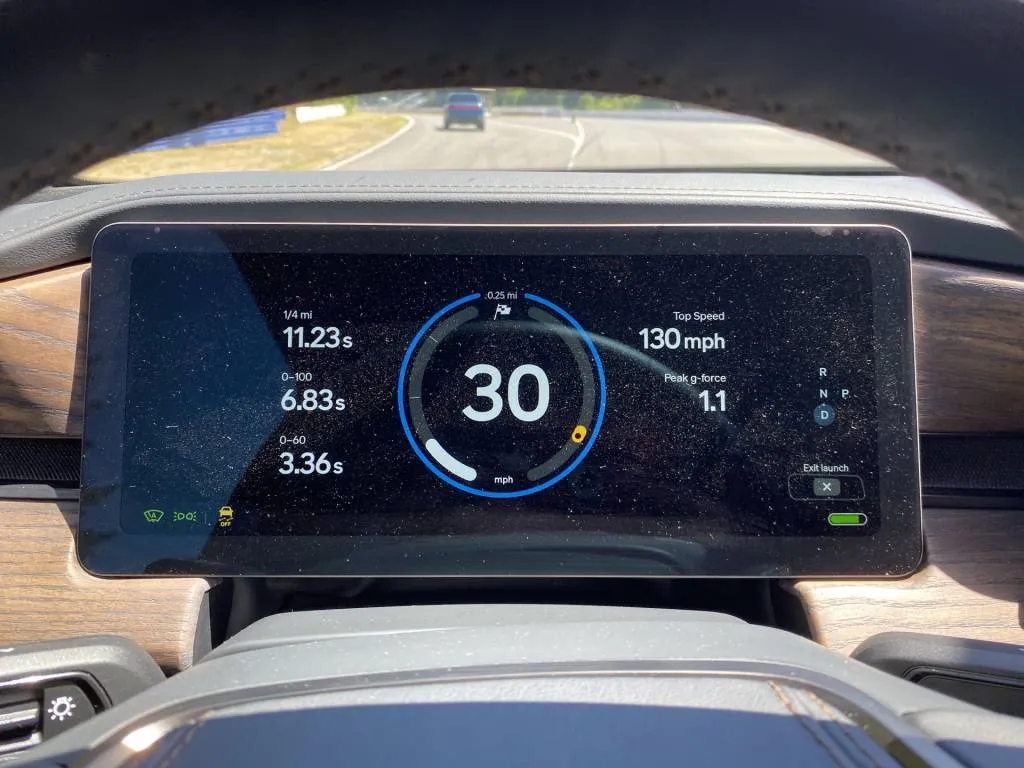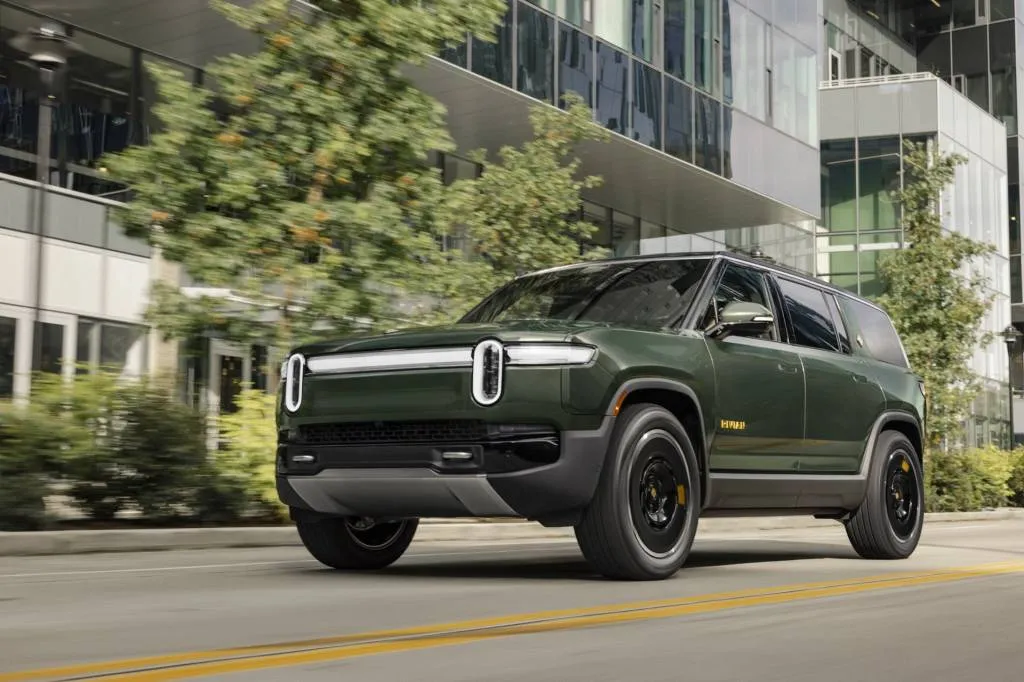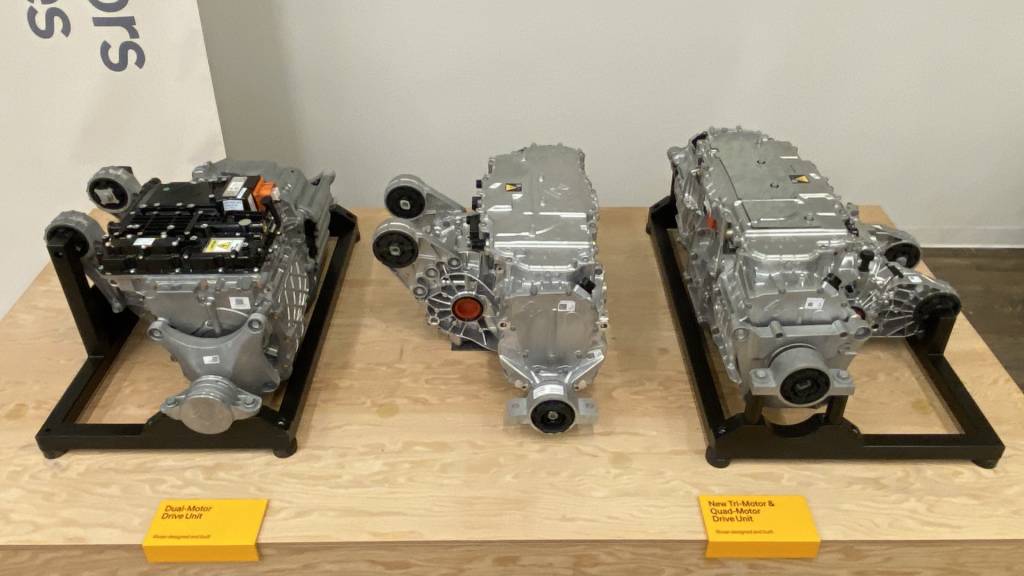- The 2025 Rivian R1S and R1T quad-motor models are more powerful and quicker than before
- Despite being quicker the acceleration doesn’t feel as violent as in the GMC Hummer EV
- The Rivian R1T and R1S are now the quickest SUVs and pickup trucks money can buy
Rivian pegs its Quad-Motor R1 trucks at as little as 2.5 seconds to 60 mph.
Yes, that’s quicker than the three-motor Tesla Cybertruck in beast mode. And it’s quicker than the three-motor GMC Hummer EV in its WTF mode.
It also beats the Ram TRX, the Lamborghini Urus, the Durango Hellcat. You name it.
And I got to experience last week how easy it was to churn out three-second 0-60 times in the 2025 Rivian R1T and R1S. As Rivian CEO RJ Scaringe demonstrated in a quick video post on Friday, it’s so accessible, and it requires just a few steps.
Launch Mode is fantastic!! pic.twitter.com/BTlVMIUQaD
— RJ Scaringe (@RJScaringe) June 7, 2024
Getting to the sub-3.0-second zone takes a little more finesse and determination, but as we found out, it’s a matter of physics in getting these big electric trucks to turn out times previously reserved for supercars.
It’s a lot of power and torque to push out to four tire patches. The Quad-Motor R1 trucks make 1,025 hp and 1,198 lb-ft of torque and can accelerate to 60 in that claimed 2.5 seconds, while the Tri-Motor R1 trucks make 850 hp and 1,103 lb-ft of torque and get there in an official 2.9 seconds.
I didn’t yet get a chance to drive the Quad-Motor R1s on the road as I had the Tri-Motor version in Motor Authority’s 2025 Rivian R1S and R1T first drive, but Rivian afforded journalists a chance to preview the Quad with some runs on a proper NHRA-prepped drag strip this past week.
It was enough to say that off-the-line the Tri- and Quad-Motor models are likely going to be quite even in real-world acceleration at legal speeds because it’s tire- and traction-limited.
Rivian R1 performance goes staggered-width
To optimize traction and access those top times, Rivian fitted Quad-Motor models with the available staggered-width Michelin Ultra High-Performance tire package—adding 22-inch Michelin Pilot Sport 5 rubber in 275- and 305-mm widths front and rear, respectively.
Just off the line, the Quad-Motor R1T doesn’t feel as gut-sink brutal as the Hummer EV in WTF Mode—perhaps a matter of seating height—but it makes up for it right after that, with a blur to 60 mph that felt nearly like an on-off switch. There was a little bit of traction management in front and in back, but I felt like I could do this all day.
2025 Rivian R1S Quad-Motor
Next up, I was in a Quad-Motor R1S and it felt completely different on the drag strip—with much more of a shift in mass to the rear wheels, leaving the fronts scrambling a bit more. I was instructed to hold on tight to the steering wheel at 10 and 2, and it wasn’t until I was in the R1S that I understood why this had been emphasized multiple times. In Tri-Motor versions of the R1S, you feel light blipping of the brakes at either of the front wheel to get the right balance off the line. But in the Quad-Motor version here, the electronics let it rip, modulating the front motors to gently pull hard back and forth instead.
That difference in the way the R1S and R1T shift their weight around—and end up launching differently, despite the same wheels, tires, and propulsion system—is to be expected, given the R1T’s 12-inch-longer wheelbase and pickup layout, versus the R1S’s SUV layout. Actual curb weight totals are yet to come, but we’re told that the 2025 models will lose weight.
R1S and R1T shift their weight around differently
“For the straight-line launch, we need to get torque to the rear wheels, that’s where the grip is, and we also need to offset for the weight distribution,” which is a little more rear-biased in the R1S, explained Luke Lynch, Rivian’s director of vehicle dynamics. Lynch said that that getting the suspension in tune for the right launch ended up being a bit of a compromise versus all the other ride-and-handling situations these vehicles will encounter.
In Rivian’s Gen 2 models, some of the company’s updates to suspension and ride tuning coordinate with the motor changes and apply differently to R1S than to R1T, with a decrease in the front spring rate and increase of the rear spring rate applying primarily to R1S, essentially making the vehicle feel more refined and level—although both models get new bushings, damper tuning, and other secondary ride changes, as well as new tuning of the hydraulic roll system.
I’m told that you *can* get the same kind of time with the SUV—maybe even quicker in the quarter-mile because of aero—if you hook up well from the start, and that the lift of the brake pedal is key. But especially in the R1S it may be a matter of hooking up at those front wheels.
Rivian also says that with just the right hookup it can do the quarter mile in just 10.5 seconds—also quicker than the Cybertruck. I do just over 11 with a less-than-ideal launch in the R1S.

2025 Rivian R1S Quad-Motor
I have a little extra space, so just to see how it feels, I keep my right foot planted deep after the quarter-mile ends, pegging these models’ limiter at 130 mph. There’s no aerodynamic hurricane or front-end lightness; the R1S feels planted and secure, with its front-end lightness strictly limited to all the torque of its launch.
Underneath it all, Rivian’s new motor units and inverter tech is a key factor in these improved times. In Tri- and Quad-Motor versions, peak power output can be maintained to essentially a higher speed now.
Rivian engineers explained that this is related to several factors. Optimizing the gearing of the motors is part of it. They’re now at an 11.7:1 reduction ratio in the back versus 9.1:1 in front, versus 12.6:1 for all four with the previous Quad-Motor setup.
R1S and R1T passing power leaps ahead
Previously, power would start dropping off by 40 mph, when you’d start getting back voltage that effectively cuts the current and power, but now it’s around 50 mph. Given the motor and gearing changes, around 60 mph you’re still near peak output, according to Mason Verbridge, Rivian’s principle drive engineer.
“That’s where it starts to decay, but the 60-80 (mph) figure we’ve kind of used as a metric is way up,” said Verbridge.

2025 Rivian R1S
What seemed even more impressive, relative to other EVs, is that claimed 60-80 mph acceleration time Verbridge was referring to: 1.5 seconds. Rivian did all its own development and physics work with the inverter and motor control algorithm, so it’s as much about returning impressive range as it is providing those quick bursts of passing power. I’m eager to see how that plays out in real-world trips.
In the meantime, looking to parse out what the difference between Tri- and Quad-Motor versions feels like? Translate these drag strip results to the real world, based on what I saw, and these trucks can reliably do 0-60 in about three seconds, while the Quad-Motor can shave tenths of a second off if given the right surface.
While there may not be a Tank Turn, I bet Rivian has some other future uses for that fourth motor in the works, too.
Rivian paid for accommodation plus food onsite to help facilitate this review.



